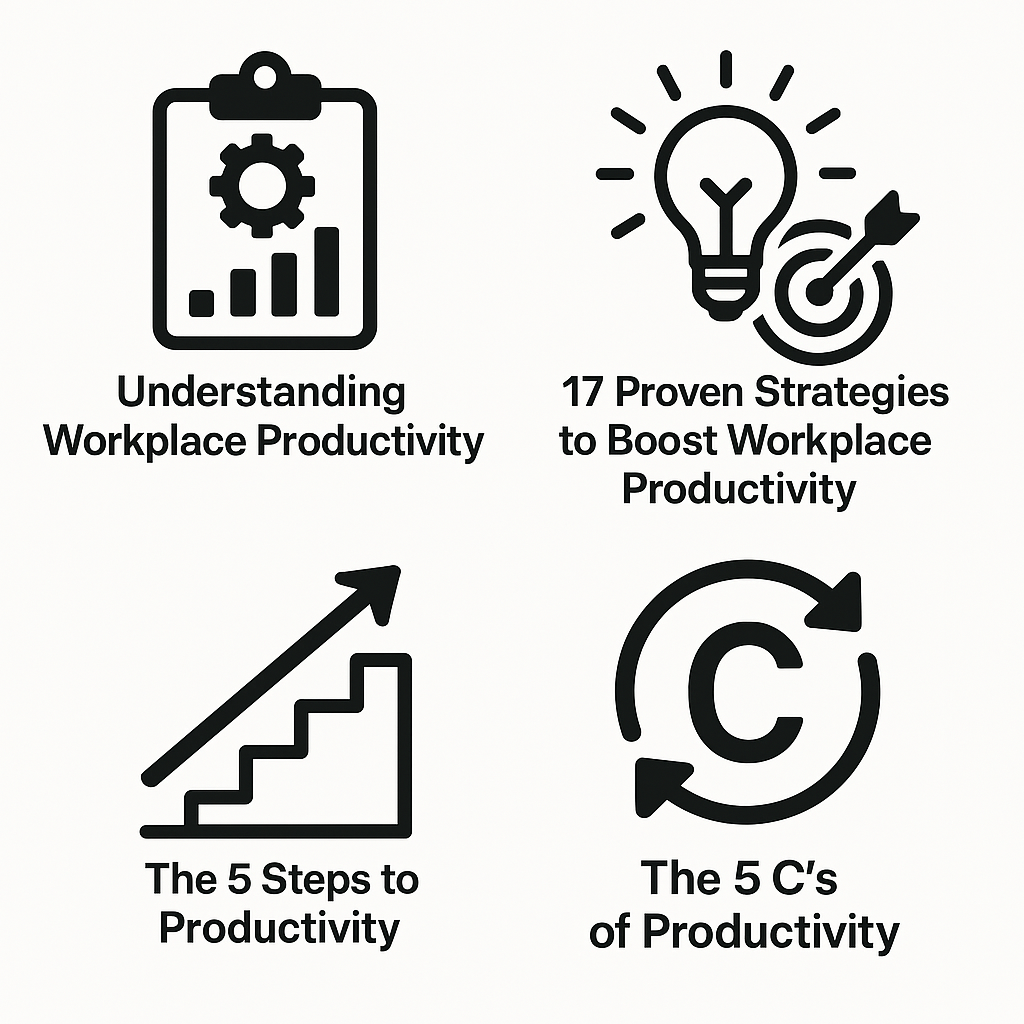Have you noticed your team's output declining? Are deadlines being missed more frequently? Understanding how to improve workplace productivity isn't just about working harder—it's about working smarter. This comprehensive guide offers practical strategies that can transform your workplace efficiency starting today.
Understanding Workplace Productivity
Workplace productivity measures how efficiently employees complete tasks and achieve goals. It's not about constant busyness, but rather about maximizing output while optimizing resources.
The 3 Types of Productivity:
- Labor productivity - Output per worker hour
- Capital productivity - Output relative to capital investment
- Total factor productivity - Output considering all resources used

The 5 Main Factors That Affect Productivity
Understanding what impacts productivity is the first step toward improvement:
-
Workplace Environment
- Physical comfort (ergonomics, temperature, lighting)
- Noise levels and distractions
- Office layout and organization
-
Technology and Tools
- Up-to-date software and hardware
- Automation capabilities
- Technical support availability
-
Management Practices
- Leadership style and approach
- Goal-setting and expectations
- Feedback and recognition systems
-
Employee Wellbeing
- Work-life balance
- Stress management
- Health and energy levels
-
Skill Level and Training
- Knowledge and expertise
- Ongoing professional development
- Training opportunities
17 Proven Strategies to Boost Workplace Productivity
Optimize the Work Environment
-
Create a comfortable workspace
- Invest in ergonomic furniture
- Optimize lighting (natural light when possible)
- Maintain comfortable temperature (68-72°F)
-
Minimize distractions
- Designate quiet zones for focused work
- Implement "do not disturb" signals
- Establish effective meeting protocols
-
Organize physical and digital spaces
- Implement the 5S methodology (Sort, Set in order, Shine, Standardize, Sustain)
- Create logical filing systems
- Declutter regularly
Leverage Technology Effectively
-
Implement productivity tools
- Project management software
- Time-tracking applications
- Communication platforms
-
Automate repetitive tasks
- Email templates and responses
- Scheduling systems
- Data entry and processing
-
Provide technical training
- Regular software updates training
- Digital literacy improvements
- Technology troubleshooting basics
Enhance Management Approaches
-
Set clear, achievable goals
- Use SMART criteria (Specific, Measurable, Achievable, Relevant, Time-bound)
- Break large projects into manageable tasks
- Communicate priorities effectively
-
Implement effective feedback systems
- Regular check-ins (not just annual reviews)
- Constructive, specific feedback
- Recognition for achievements
-
Delegate appropriately
- Match tasks to employee strengths
- Provide necessary authority with responsibility
- Develop trust through delegation
Prioritize Employee Wellbeing
-
Promote work-life balance
- Reasonable working hours
- Flexible scheduling when possible
- Respect for time off
-
Address burnout proactively
- Recognize early warning signs
- Provide mental health resources
- Encourage regular breaks
-
Support physical health
- Ergonomic workstations
- Movement opportunities throughout the day
- Wellness program implementation
Develop Skills and Knowledge
-
Invest in training
- Regular skill development opportunities
- Cross-training for versatility
- Mentoring programs
-
Encourage knowledge sharing
- Team presentations
- Documentation of processes
- Collaborative problem-solving sessions
-
Support professional growth
- Clear career pathways
- Learning and development budgets
- Industry certification support
Foster a Productive Culture
-
Build team cohesion
- Team-building activities
- Collaborative projects
- Recognition and appreciation practices
-
Promote innovation
- Brainstorming sessions
- "Innovation time" allowances
- Rewards for improvement suggestions
The 5 Steps to Productivity
Transform how your team works with this sequential approach:
-
Planning
- Set clear objectives
- Create detailed action plans
- Establish priorities
-
Organizing
- Gather necessary resources
- Structure workflows
- Assign responsibilities
-
Staffing
- Match skills to requirements
- Provide necessary training
- Ensure adequate team capacity
-
Directing
- Provide clear instructions
- Offer ongoing guidance
- Remove obstacles promptly
-
Controlling
- Monitor progress regularly
- Adjust approaches as needed
- Evaluate and improve processes
The 5 C's of Productivity
Remember these fundamental principles:
- Clarity - Crystal clear goals and expectations
- Competence - Necessary skills and knowledge
- Creativity - Innovative approaches to challenges
- Consistency - Regular, reliable work patterns
- Commitment - Dedication to quality and improvement
The 3 P's of Productivity
The simplest productivity framework focuses on:
- Purpose - Understanding the "why" behind tasks
- Priority - Focusing on high-impact activities
- Performance - Executing with excellence
Productivity in Different Work Environments
Different settings require tailored approaches:
Office Settings
- Designated focus times
- Effective meeting management
- Strategic office layout
Remote Work
- Virtual collaboration tools
- Clear communication protocols
- Work-home boundaries
- Remote work best practices
Hybrid Models
- Consistent expectations across locations
- Inclusive meeting practices
- Equitable opportunity distribution
Common Productivity Challenges and Solutions
Challenge: Procrastination
Solution:
- Break tasks into smaller steps
- Use time-blocking techniques
- Implement the "2-minute rule" (do it now if it takes less than 2 minutes)
Challenge: Meeting Overload
Solution:
- Question meeting necessity
- Create and distribute agendas beforehand
- Establish meeting-free blocks
Challenge: Email Overwhelm
Solution:
- Set specific email checking times
- Use templates for common responses
- Implement the OHIO principle (Only Handle It Once)
Challenge: Lack of Motivation
Solution:
- Connect tasks to larger purpose
- Create milestone celebrations
- Use productivity partners for accountability
- Implement effective recognition
Frequently Asked Questions
How can productivity be improved in the workplace?
Productivity improvements come from a combination of optimized environments, effective technology use, supportive management practices, employee wellbeing initiatives, and ongoing skill development. Start by identifying your specific productivity barriers, then implement targeted solutions from our 17 strategies above.
What are the 5 steps to productivity?
The five fundamental steps to productivity are Planning (setting clear objectives), Organizing (structuring resources and workflows), Staffing (matching skills to needs), Directing (providing guidance), and Controlling (monitoring and adjusting). Following this sequence ensures comprehensive productivity management.
What are the 5 main factors that affect productivity?
The five main factors affecting workplace productivity are the physical environment, available technology and tools, management practices, employee wellbeing, and skill levels. Addressing all five areas creates a foundation for sustained productivity improvements.
How to be highly productive at work?
High personal productivity comes from: setting clear daily priorities, minimizing distractions, taking strategic breaks, using appropriate productivity tools, maintaining physical and mental wellbeing, and continuously developing skills. Focus on progress rather than perfection.
How to make staff more productive?
Boost staff productivity by providing clear expectations, removing obstacles, offering necessary resources and tools, recognizing achievements, facilitating skill development, and creating a positive work environment. Remember that productivity is a result of both capability and motivation. Learn more about performance management.
What is the main source of increased productivity?
The primary source of productivity growth is typically technological innovation, followed by process improvements, skills development, and enhanced management practices. Organizations that integrate all these sources experience the most significant productivity gains.
What are the 5 C's of productivity?
The 5 C's framework includes Clarity (clear goals), Competence (necessary skills), Creativity (innovative thinking), Consistency (reliable patterns), and Commitment (dedication to excellence). These principles form the foundation of sustainable productivity.
What are the 3 P's of productivity?
The 3 P's are Purpose (understanding why tasks matter), Priority (focusing on high-impact activities), and Performance (executing with excellence). This simplified framework helps maintain focus on the essentials of productivity.
How to improve work efficiency?
Improve efficiency by eliminating unnecessary steps, automating repetitive tasks, developing standardized processes, implementing appropriate technology, providing adequate training, and regularly reviewing and refining workflows. Explore performance review improvements.
Why do I struggle to be productive at work?
Common productivity struggles stem from unclear priorities, excessive distractions, ineffective tools, inadequate skills, poor time management, low energy or motivation, or misalignment between tasks and strengths. Identifying your specific barriers is the first step toward improvement.
How do I tell my employee to be more productive?
Address productivity concerns through specific, constructive feedback focused on behaviors rather than character. Offer support through clear expectations, necessary resources, and skill development opportunities. Frame the conversation around mutual success rather than criticism. Learn effective feedback techniques.
What is an example of productivity?
A classic productivity example is an automobile assembly line worker who previously completed 5 vehicle assemblies per shift now completing 6 assemblies of equal quality in the same time period. This represents a 20% productivity increase through improved processes or technology.
What are the 3 types of productivity?
The three main productivity types are labor productivity (output per worker hour), capital productivity (output relative to capital investment), and total factor productivity (output considering all resources). Different contexts may prioritize different types.
Which is most likely to improve the productivity of workers?
Research consistently shows that a combination of appropriate tools, clear expectations, supportive management, skill development, and intrinsic motivation most reliably improves worker productivity. No single factor works in isolation. Explore our performance management resources.
How can productivity be improved?
Productivity improves through systematic attention to workplace environment, technology utilization, management practices, employee wellbeing, and skill development. The most successful approaches address both the technical aspects (tools and processes) and human elements (motivation and capabilities).
Implementing even a few of these strategies can significantly impact your organization's productivity. Start with the areas that present the biggest challenges in your specific workplace, then gradually expand your productivity initiatives for comprehensive improvement.
Want more insights on workplace efficiency? Check out our related articles on effective performance reviews and creating a positive company culture.
